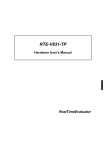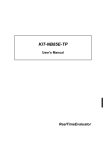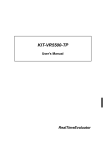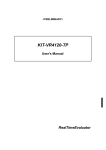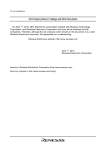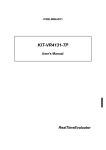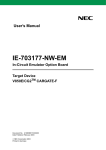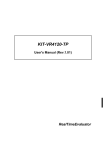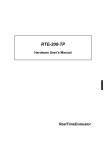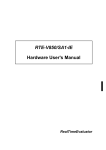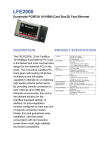Download User`s Manual
Transcript
KIT-V831-TP
User's Manual
RealTimeEvaluator
KIT-V831-TP
User’s Manual
Revision History
Rev.1.0
April 26,1997
1st edition
1
KIT-V831-TP
User’s Manual
CONTENTS
1. OVERVIEW....................................................................................................................................... 3
2. HARDWARE SPECIFICATIONS ....................................................................................................... 4
Emulation........................................................................................................................................... 4
Host system and interface .................................................................................................................. 4
3. RTE FOR WIN32............................................................................................................................... 5
Starting ChkRTE32.exe ...................................................................................................................... 5
4. INITIALIZATION COMMANDS.......................................................................................................... 6
env command..................................................................................................................................... 6
rom command .................................................................................................................................... 7
5. INTERFACE SPECIFICATIONS ........................................................................................................ 8
Pin arrangement table ........................................................................................................................ 8
Connectors......................................................................................................................................... 8
Wire length......................................................................................................................................... 8
Layout of the connectors on the board ................................................................................................ 9
6. PRECAUTIONS .............................................................................................................................. 10
Precautions related to operation ....................................................................................................... 10
Precautions related to functions ........................................................................................................ 10
2
KIT-V831-TP
User’s Manual
1. OVERVIEW
KIT-V831/2-TP is a product to use RTE-100-TP. It is an In-circuit emulator for NEC's RISC processor,
V831 and V832 by using KIT-V831/2-TP and RTE-100-TP together.
Please read a User's Manual of RTE-100-TP together.
This product comes with the following components. First check that none of the components are
missing.
1. RTE for Win32 Setup Disk
1
2. User's manual
1
3. License sheet
1
3
KIT-V831-TP
User’s Manual
2. HARDWARE SPECIFICATIONS
Emulation
Target device
V831/2
RTE-PC
RTE-100-TP
Emulation functions
Operating frequency
V831:100 MHz (max.),V832:143MHz(max.)
Interface
JTAG/N-Wire
Break functions
H/W break points (execution addresses)
2
S/W break points
100
Breaks that can be set using access events
4
Step breaks
Supported
Manual breaks
Supported
Trace functions
Trace data bus
4 bits
Trace memory
4 bits x 128K words
Trigger that can be set using an execution address
1
Start that can be set using an execution address
1
Stop that can be set using an execution address
1(only V832)
Trace delay
0 - 1FFFFh
Trace clock
66 MHz (max.)
Data trace conditions
2
Disassembled trace data display function
Provided
ROM emulation functions
Memory capacity
4 M-Byte
Access time
50 ns
Number of ROMs that can be emulated
DIP-32pin-ROM (8-bit ROM)
4 (max.)
DIP-40/42pin-ROM (16-bit ROM)
2 (max.)
STD-16BIT-ROM connector
2 (max.)
Types of ROMs that can be emulated
DIP-32-ROM probe(bits)
1M, 2M, 4M, 8M (27C010/020/040/080)
DIP-40-ROM probe(bits)
1M, 2M, 4M (27C1024/2048/4096)
DIP-42-ROM probe(bits)
8M, 16M (27C8000/16000)
Bus width specification (bits)
8/16/32
Target ROM capacity (bits)
512K, 1M, 2M, 4M, 8M, 16M(*1)
Pin mask functions(*2)
INT00-03/10-13, NMI, RESET, HLDRQ
*1 An 8-bit ROM probe supports ROMs of up to 8M bits.
*2 Depends on the CPU specifications.
Host system and interface
Item
Description
Target host machine
PC 9800 Series and DOS/V PCs
Debugger
GHS-Multi, Partner/Win (Windows95/98/NT)
Interface
PC card Type II (version 2.1 of the PCMCIA specifications/version 4.2 of the JEIDA
specification or later)
PC 9800 (C bus), PC/AT (ISA bus and PCI bus), or LAN-BOX
Power supply
AC adapter (in: 100 V out: +5 V, 2A)
4
KIT-V831-TP
User’s Manual
3. RTE FOR WIN32
This chapter describes the setting of RTE for WIN32, with the focus on the aspects specific to KITV831/2-TP.
Starting ChkRTE32.exe
Start ChkRTE32.exe after RTE-100-TP has been connected to the user system and the power to all the
devices is on. When RTE-100-TP is installed for the first time, ChkRTE32.exe must be started once to
select RTE.
<Selecting RTE>
Set the Setup dialog box of ChkRTE32.exe, as follows.
*Select V831-TP or V832-TP in RTE: section .
<Function test>
If RTE-100-TP is properly connected to the user system and capable of debugging, the following dialog
box appears upon the normal completion of the function test. In this state, control from the debugger is
possible.
If an error occurs during the test, the N-Wire cable is not properly connected. Check its connection.
Perform the ChkRTE32.exe function test after the RTE-100-TP has
been connected to the user system and the power to all the devices
has been turned on.
5
KIT-V831-TP
User’s Manual
4. INITIALIZATION COMMANDS
Before debugging can be started, initialization is required. The following explains initialization using the
appropriate internal commands. If the debugger offers a means of initialization, they may be used instead.
(See Appendix A for an explanation of starting the internal commands and an explanation of the other
internal commands.)
env command
[Format]
env [[!]auto] [[!]reset] [[!]nmi] [[!]hldrq] [[!]int{00|01|02|03}] [[!]int{10|11|12|13}]
[jtag{25|12}] [!]verify [inone|istack|iaddr ADDR]
[Parameters]
[!]auto
If a break point is encountered during execution, the break point causes a temporary break.
Choose [Auto] to automatically perform the subsequent execution. Choose [!auto] to suppress it.
[!]reset
This parameter specifies whether the RESET pin is to be masked. Enter ! if it is not to be
masked.
[!]nmi
This parameter specifies whether the NMI pin is to be masked. Enter ! if it is not to be masked.
[!]hldrq
This parameter specifies whether the HLDRQ pin is to be masked. Enter ! if it is not to be
masked.
[!]int{00|01|02|03}
This parameter specifies that pins INT00 to INT03 are to be masked. Enter ! if they are not to be
masked.
[!]int{10|11|12|13}
This parameter specifies that pins int10 to int13 are to be masked. Enter ! if they are not to be
masked.
jtag[12|25]
This parameter specifies the JTAG clock for N-Wire. Usually, use jtag25.
[!]verify
This parameter specifies the verification after writing memory is set. Enter ! if it is not to be set.
[inone|istack|iaddr ADDR]
This parameter apecifies the work ram area when debugger accesses the V832 internal
instruction ram.
inone
: not spcified
Istack
: This parameter specifies the area from current 32-byte stack.
Iaddr ADDR : This parameter specifies the area from ADDR to ADDR + 32-byte.
[Function]
The env command sets the emulation environment. Enter only those parameters that need to be
changed. Parameters may be entered in any order. If the same parameter is entered twice, only
the last entry is valid.
6
KIT-V831-TP
User’s Manual
rom command
<Format>
rom [ADDRESS [LENGTH]] [512k|1m|2m|4m|8m|16m] [rom8|rom16] [bus8|bus16]
<Parameters>
ADDRESS [LENGTH]
ADDRESS:
Lowest address of the ROM to be emulated. (An error occurs if it does
not match a ROM boundary.)
LENGTH:
Number of bytes of the ROM to be emulated. (Must be specified in
boundary units of 16 bytes.)
512k|1m|2m|4m|8m|16m
Specify the bit size of the ROM to be emulated. Sizes from 512K bits to 16M bits can be
specified. For the 27C1024, for example, specify 1M bits.
rom8|rom16
Specify the number of data bits of the ROM to be emulated. Either 8 bits or 16 bits can
be specified. If a DIP-32-ROM probe is used, choose rom8; if a DIP-40/42-ROM probe
is used, choose rom16.
bus8|bus16|bus32
Specify the ROM bus size in the system to be emulated. 8 bits, 16 bits, or 32 bits can be
specified.
<Function>
The rom command sets the ROM emulation environment. Enter only the parameters that need to be
changed. Parameters may be entered in any order. If the same parameter is entered twice, only the
last entry is valid. The initial value of LENGTH is 0 (not used).
<Examples>
rom C0000 40000 1m rom16 bus16
The 256K bytes (40000) of the 27C1024 (16-bit ROM with a size of 1M bits), starting at
0xc0000, are emulated. Consequently, two 16-bit ROMs are emulated.
rom fff80000 80000 2m rom rom16 bus32
The 512K bytes (80000) of the 27C2048 (16-bit ROM with a size of 2M bits), starting at
0xfff80000, are emulated. Consequently, two 16-bit ROMs are emulated.
<Note>
Access to the range specified by the rom command results in direct access to internal emulation
memory. Access to addresses outside the range is performed via the processor bus.
7
KIT-V831-TP
User’s Manual
5. INTERFACE SPECIFICATIONS
This chapter describes the specifications of the connectors used for control that are required for the user
system.
Pin arrangement table
Pin number
Signal name
Input/output (user side)
A1
CPUCLK
Output
Treatment (user side)
Buffered and 33-Ω series resistor
(recommended)
A2
TRCDATA0
Output
Buffered and 33-Ω series resistor
(recommended)
A3
TRCDATA1
Output
Buffered and 33-Ω series resistor
(recommended)
A4
TRCDATA2
Output
Buffered and 33-Ω series resistor
(recommended)
A5
TRCDATA3
Output
Buffered and 33-Ω series resistor
(recommended)
A6
TRCEND
Output
Open
A7
DDI
Input
10-kΩ pullup
A8
DCK
Input
10-kΩ pulldown
A9
DMS
Input
10-kΩ pulldown
A10
DDO
Output
A11
DRST-
Input
10-kΩ pulldown
A12
NC.
------
Open
A13
NC.
------
Open
Pin number
Signal name
Input/output (user side)
B1-B10
GND
------
Connection to the power GND
B11
NC.
------
Open
B12
NC.
------
Open
B13
+3.3V
------
Connection to the power
33-Ω series resistor (recommended)
Treatment (user side)
Connectors
Manufacturer: KEL
Models:
8830E-026-170S (straight)
8830E-026-170L (right angle)
8831E-026-170L (right angle, fixing hardware attached)
Wire length
Keep the wire from CPU to the connector as short as possible.
>>100 mm or shorter is recommended.
8
KIT-V831-TP
User’s Manual
Layout of the connectors on the board
The figure below shows the physical layout of the connectors on the board.
B13 A13
B12 A12
Polarity indication
B2 A2
B1 A1
Board end
[Top View]
Note: When actually arranging the pins, design them according to the connector dimensional
information.
9
KIT-V831-TP
User’s Manual
6. PRECAUTIONS
This chapter provides precautionary information on the use of KIT-V831/2-TP.
Precautions related to operation
1) Do not turn on the power to the user system while the power to RTE-1001-TP is off. Doing so can
cause a malfunction.
2) KIT-V831/2-TP externally controls the debugging control circuit built into V831/2. Consequently,
RTE-100-TP does not operate correctly unless the following conditions are satisfied:
* RTE-100-TP is properly connected to the user system using the N-Wire cable.
* The power to the user system is on so that V831/2 can run correctly.
Precautions related to functions
1) The disassembly and display of real-time trace data is performed by reading the contents of memory
at the point the trace display command is issued, according to the branching information received
from V831/2. Consequently, the disassembly and display of the program located in RAM of the user
system is not correct if changes (including erroneous writing due to a runaway CPU) are made after
program execution. In addition, branching information may not be analyzed correctly because not
all branching information may be output.
10














